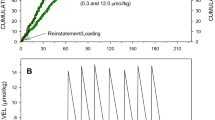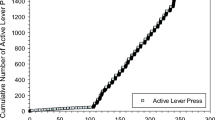Abstract
Debate continues as to whether drug discrimination in animals is an inherently quantal or continuous process. This issue is important in determining the appropriate interpretation of results from drug discrimination studies designed to assess the nature of drug-induced interoceptive cues. The quantal approach holds that subjects perceive a drug cue in an all-or-none manner, while the continuous view proposes that when appropriate training and testing procedures are used, subjects can discriminate along a continuum of interoceptive cues. Data consistent with the quantal view have consistently been generated by animals trained to respond on schedules of reinforcement having an FR component. Since quantal responding is a characteristic of these schedules, results from drug discrimination studies using training schedules with FR components are of little value in empirically determining whether drug discrimination reflects a quantal or continuous process. Use of variable schedules of reinforcement might be more appropriate because the pattern of responding generated does not preclude results consistent with either of the competing views. Data from the following studies that trained subjects using VI schedules with a concurrent TO for incorrect lever responding were analyzed: Barrett et al. (1982): L-5-hydroxytryptophan versus saline; Smith (1990): diazepam versus pentylenetetrazol; Barrett et al. (1992): amphetamine versus haloperidol; Barrett and Steranka (1983): amphetamine versus haloperidol. In every case, when experimental conditions produced a group mean intermediate to that for the training drugs, the distribution of scores for individual animals was normally rather than bimodally distributed.
Similar content being viewed by others
References
Barrett RJ, Smith RL (1988) Time dependent pentylenetetrazol-like cues subsequent to diazepam administration. Psychopharmacology 96:169–173
Barrett RJ, Steranka LR (1983) Drug discrimination in rats: evidence for amphetamine-like cue state following chronic haloperidol. Pharmacol Biochem Behav 18:611–617
Barrett RJ, Blackshear MA, Sanders-Bush E (1982) Discriminative stimulus properties of L-5-hydroxytryptophan: behavioral evidence for multiple serotonin receptors. Psychopharmacology 76:29–35
Barrett RJ, White DK, Caul WF (1992) Tolerance, withdrawal, and super-sensitivity to dopamine mediated cues in a drug-drug discrimination. Psychopharmacology 109:63–67
Colpaert FC, (1977) Drug-produced cues and states: some theoretical and methodological inferences. In: Lal H (ed) Discriminative stimulus properties of drugs. Plenum Press, New York, pp 5–21
Colpaert FC (1985) Drug discrimination and the behavioral analysis of drug action. In: Lowe CF, Richelle M, Blackman DE, Bradshaw CM (eds) Discriminative stimulus properties of drugs. Erlbaum, London, pp 205–216
Colpaert FC (1987) Drug discrimination: Methods of manipulation, measurement, and analysis. In: Bozarth MA, (ed) Methods of assessing the reinforcing properties of abused drugs. Springer, Berlin Heidelberg New York, pp 341–372
Colpaert FC, Niemegeers CJE, Janssen PAJ (1976) Theoretical and methodological considerations on drug discrimination learning. Psychopharmacology 46:169–173
D'Mello GD, Stolerman, IP (1978) Methodological issues in drug discrimination research. In: Colpaert FC, Rosecrans JA (eds) Stimulus properties of drugs: ten years of progress. Elsevier, Amsterdam, pp 243–252
Ferster CB, Skinner BF (1957) Schedules of reinforcement. Appleton-Century-Croft, New York
Gauvin DV, Holloway, FA (1991) Cue dimensionality in the three-choice pentylenetetrazole-saline-chlordiazepoxide discrimination task. Behav Pharmacol 2:417–428
Gouvier WD, Akins, RR, Trapold MA (1984) Assessment of drug state dimensionality via drug-drug training and stimulus generalization testing. Pharmacol Biochem Behav 21:687–693
Haenlein M, Caul WF, Barrett RJ (1985) Amphetamine-haloperidol discrimination: effects of chronic drug treatment. Pharmacol Biochem Behav 23:949–952
Harris CM, Emmett-Oglesby MW, Mathis DA, Lal H (1988) Quantal detection and homogeneous sensitivity in a pentylenetetrazol discrimination. Psychopharmacology 94:183–187
Hayes WL (1963) Statistics. Holt, Rinehart and Winston, New York
Holloway FA, Gauvin DV (1989) Comments on method and theory in drug discrimination: a potpourri of problems, perplexities, and possibilities. Drug Dev Res 16:195–207
Krimmer EC, Mcguire MS, Barry H III (1984) Effects of the training dose on generalization of morphine stimulus to clonidine. Pharmacol Biochem Behav 20:669–673
Kubena RK, Barry H III (1969) Two procedures for training differential responses in alcohol and nondrug conditions. J Pharmacol Sci 58:99–101
Massey BW, McMillan DE, Wessinger WD (1992) Discriminative-stimulus control by morphine in the pigeon under fixed-interval schedule of reinforcement. Behav Pharmacol 3:475–488
Mathis DA, Emmett-Oglesby MW (1990) Quantal versus graded generalization in drug discrimination: measuring a graded response. J Neurosci Method 31:23–33
Michaelis RC, Holohean AM, Criado JR, Harland RD, Hunter GA, Holloway FA (1988) The chlordiazepoxide/pentylenetetrazol discrimination: characterization of drug interactions and homeostatic responses to drug challenges. Psychopharmacology 96:15–20
Smith RL (1990) Use of diazepam-pentylenetetrazol discrimination in rats to investigate adaptive processes following acute and chronic diazepam. Unpublished dissertation, Vanderbilt University
Stolerman IP (1989) Discriminative stimulus effects of nicotine in rats trained under different schedules of reinforcement. Psychopharmacology 97:131–138
Stolerman IP (1991) Measures of stimulus generalization in drug discrimination experiments. Behav Pharmacol 2:265–282
Stolerman IP, Garcha HS, Rasul F (1990) Quantal and quantitative drug discrimination. Psychopharmacology 101:S75
Williams BA (1987) Limitations on the notions of quantal stimulus control. Psychol Rec 37:193–198
Young AM (1991) The time is ripe for an experimental analysis of measurement issues Commentary on Stolerman's “Measurement issues in drug discrimination.” Behav Pharmacol 2:287–291
Author information
Authors and Affiliations
Additional information
Some of these data were presented at the meeting of the Society for Neuroscience, Anaheim, CA, 1992, USA
Rights and permissions
About this article
Cite this article
Barrett, R.J., Caul, W.F., Huffman, E.M. et al. Drug discrimination is a continuous rather than a quantal process following training on a VI-TO schedule of reinforcement. Psychopharmacology 113, 289–296 (1994). https://doi.org/10.1007/BF02245196
Received:
Revised:
Issue Date:
DOI: https://doi.org/10.1007/BF02245196




